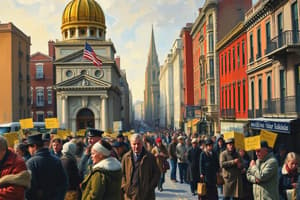Podcast
Questions and Answers
What primary factor contributed to the nearly doubling of the USA's population between 1830 and 1850?
What primary factor contributed to the nearly doubling of the USA's population between 1830 and 1850?
- Westward expansion of existing American settlers
- An increase in birth rates among Native Americans
- The influx of immigrants from China, Ireland, and Germany (correct)
- The establishment of new American colonies overseas
Which group faced restrictions such as being forbidden from obtaining citizenship in the USA during the mid-19th century?
Which group faced restrictions such as being forbidden from obtaining citizenship in the USA during the mid-19th century?
- Chinese migrants (correct)
- Irish migrants
- German farmers
- Mormon settlers
What role did the Irish typically find for themselves upon migrating to the USA during the Great Potato Famine?
What role did the Irish typically find for themselves upon migrating to the USA during the Great Potato Famine?
- Wealthy merchants in Midwestern towns
- Laborers on large-scale farms
- Successful entrepreneurs in agriculture
- Servants and manual laborers in cities (correct)
How did the transition experience differ between German and Irish migrants to the USA?
How did the transition experience differ between German and Irish migrants to the USA?
Which city was NOT primarily noted for Irish migration during the 1840s and 1850s?
Which city was NOT primarily noted for Irish migration during the 1840s and 1850s?
What political party emerged as a voice for nativism during the 1840s and 1850s?
What political party emerged as a voice for nativism during the 1840s and 1850s?
What was a common form of resistance among slaves in the South?
What was a common form of resistance among slaves in the South?
What did the American Anti-Slavery Society oppose?
What did the American Anti-Slavery Society oppose?
Which notable figure is associated with the abolition movement for his publication, The Liberator?
Which notable figure is associated with the abolition movement for his publication, The Liberator?
What significant event for women's rights took place in 1848?
What significant event for women's rights took place in 1848?
What did Harriet Tubman famously advocate for?
What did Harriet Tubman famously advocate for?
What was one result of Nat Turner’s rebellion in 1831?
What was one result of Nat Turner’s rebellion in 1831?
Which group argued that
Which group argued that
What did the Declaration of Sentiments, signed at the Seneca Falls Convention, primarily call for?
What did the Declaration of Sentiments, signed at the Seneca Falls Convention, primarily call for?
Which two women organized the Seneca Falls Convention?
Which two women organized the Seneca Falls Convention?
What was a major economic dependency of the South in the 1840s and 1850s?
What was a major economic dependency of the South in the 1840s and 1850s?
Which of the following was NOT a method of resistance used by slaves?
Which of the following was NOT a method of resistance used by slaves?
Who is credited with coining the phrase, 'The Constitution is a covenant with death and an agreement with hell'?
Who is credited with coining the phrase, 'The Constitution is a covenant with death and an agreement with hell'?
Flashcards
Great Potato Famine
Great Potato Famine
The Irish faced widespread poverty and hardship due to the Great Potato Famine, which led to the death of millions and forced many to seek a better future in America. This event was marked by the crop failure of the potato, their staple food, and the oppressive British economic policies that exacerbated the crisis.
Chinese Migrants during the Gold Rush
Chinese Migrants during the Gold Rush
Chinese migrants were drawn to the American West during the Gold Rush in search of economic opportunities. They were mainly driven by the hopes of discovering gold and striking it rich. However, their journey was marked by racism and discrimination, as they faced resistance from those who believed they were taking away jobs and altering the social fabric of the West.
Irish Immigration Patterns
Irish Immigration Patterns
The Irish immigrants chose to settle in rapidly growing cities like New York, Boston, Philadelphia, and Chicago instead of pursuing agricultural opportunities in rural areas, as they were determined to escape the hardships associated with farming.
Chinese Immigrants' Contribution to American Society
Chinese Immigrants' Contribution to American Society
Signup and view all the flashcards
German Immigrants' Transition to America
German Immigrants' Transition to America
Signup and view all the flashcards
Know Nothing Party
Know Nothing Party
Signup and view all the flashcards
Nativism
Nativism
Signup and view all the flashcards
Expansion of Slavery
Expansion of Slavery
Signup and view all the flashcards
Free Soil Party
Free Soil Party
Signup and view all the flashcards
Underground Railroad
Underground Railroad
Signup and view all the flashcards
William Lloyd Garrison
William Lloyd Garrison
Signup and view all the flashcards
Nat Turner's Rebellion
Nat Turner's Rebellion
Signup and view all the flashcards
Abolitionists
Abolitionists
Signup and view all the flashcards
Frederick Douglass
Frederick Douglass
Signup and view all the flashcards
Elizabeth Cady Stanton
Elizabeth Cady Stanton
Signup and view all the flashcards
Susan B. Anthony
Susan B. Anthony
Signup and view all the flashcards
Sojourner Truth
Sojourner Truth
Signup and view all the flashcards
Seneca Falls Convention
Seneca Falls Convention
Signup and view all the flashcards
Declaration of Sentiments and Resolutions
Declaration of Sentiments and Resolutions
Signup and view all the flashcards
Grimke Sisters
Grimke Sisters
Signup and view all the flashcards
Study Notes
1840s-1850s: A Nation in Flux
-
US population nearly doubled between 1830 and 1850, driven by immigration and westward expansion.
-
Immigration: Chinese, Irish, and German immigrants significantly altered the nation's demographics.
- Chinese immigrants faced discrimination and hardship, settling the Pacific Coast and often working in manual labor despite facing extreme prejudice.
- The Irish Potato Famine (1845-1850) brought over one million Irish immigrants, primarily to fast-growing eastern cities like NY and Boston. They often took jobs as laborers.
- German immigrants generally had a more successful transition, settling in midwestern cities and rural areas and introducing new cultural elements like Christmas trees and beer.
- Nativism, especially through the Know Nothing Party, rose to counter and resist these large waves of immigrants. They were anti-immigrant and anti-Catholic.
-
Westward Expansion & Changing Demographics: The acquisition of new territories led to Mexicans, Mormons, and Native Americans becoming part of the United States but often facing discrimination. Mexicans, especially, experienced a struggle for equality.
-
Slavery's Grip: The southern economy remained highly reliant on slave labor (cotton production).
- The South produced 60% of the world's cotton, nearly entirely using enslaved labor.
- This economic dependency fueled resistance and opposition from the North which argued the ethical and economic flaws of slavery.
- The number of enslaved persons increased greatly from 1.5 million in 1820 to 4 million in 1860.
- Resistance to slavery included passive resistance, slowdowns, tool breaking, faking illness, and running away. The Underground Railroad played a crucial role in helping runaway slaves.
- Slave revolts, like Nat Turner's Rebellion, were common but unsuccessful, though they demonstrated the tension and fear of larger rebellions that existed across the nation.
-
Abolition Movement: The American Anti-Slavery Society, led by figures like William Lloyd Garrison and Frederick Douglass, actively campaigned against slavery.
- Abolitionists opposed the Fugitive Slave Act, and aimed for universal social reform extending beyond the abolition of slavery into other areas like temperance and women's rights.
-
Emerging Women's Rights: In 1848, the Seneca Falls Convention marked the start of the organized women's rights movement.
- Key figures like the Grimke sisters, Elizabeth Cady Stanton, Lucretia Mott, and Susan B. Anthony rallied for equality and voting rights for women.
- Although the movement faced challenges, it gained strength in the face of other major societal shifts.
Key Events & Figures
- Nat Turner's Rebellion: Most significant slave rebellion, resulting in the violent deaths of slave-owners and slaves, and fear of larger slave rebellions.
- Seneca Falls Convention: 1848 meeting to demand women's rights and equality.
- William Lloyd Garrison: Leading abolitionist, founder of The Liberator.
- Frederick Douglass: Former enslaved person who became a powerful voice against slavery through his writings and speaking.
- Harriet Tubman: Instrumental in the Underground Railroad.
- Sojourner Truth: Key figure in both abolitionism and the women's rights movement and a staunch abolitionist.
Studying That Suits You
Use AI to generate personalized quizzes and flashcards to suit your learning preferences.



